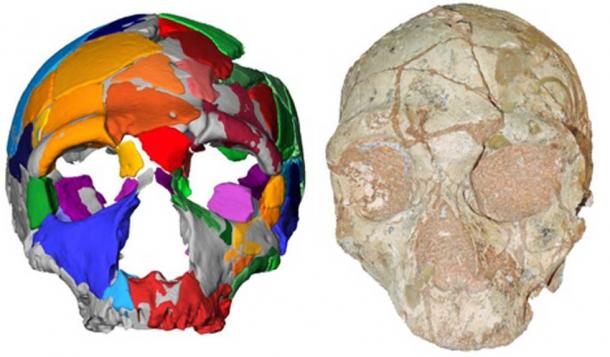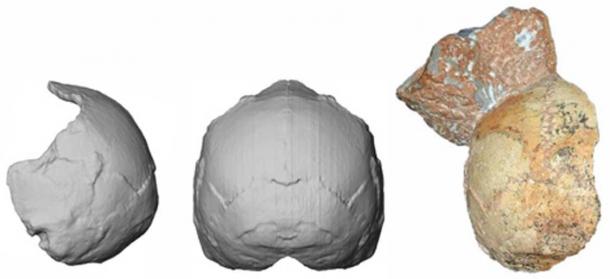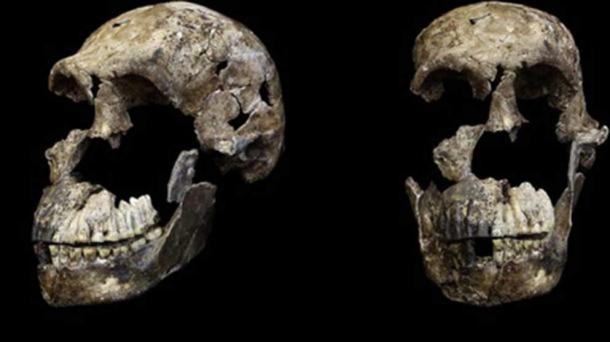A 210,000-year-old human skull could provide new evidence that our species left Africa much earlier than previously thought. A recent study published in Nature on two fossils discovered in Greece in the 1970s reveals that one of them is the oldest Homo sapiens specimen found outside of Africa by more than 50,000 years.
This exciting discovery adds to a growing list of recent findings that demonstrate the history of human migration and interaction with other related species is much more complex than we once believed.
The human skull was one of two cranial fossils found in the Apidima cave, part of a series of cave sites along the southwest coast of the Peloponnese in Greece. The first, known as Apidima 1, comprised the back half of a skull box. Apidima 2 was a largely complete skull with a clear face, but it had been heavily distorted during the fossilization process.
Initially identified as Neanderthals and considered uncontroversial specimens, both disappeared from the mainstream fossil record of humans and their closest extinct relatives (hominids).
How A Handful of Yamnaya Culture Nomads Became the Fathers of Europe Clever Rock Science Provides New Possibilities for Migration to the Americas Vast Eurasian Migration Back to Africa Revealed by Bones of 4,500-year-old Ethiopian Man

Apidima 2 and Its Reconstruction. Katerina Harvati, Eberhard Karls University of Tübingen.
However, the recent study by a multinational team led by Katerina Harvati digitally reconstructed the specimens and dated them by measuring their radioactive decay.
The “geometric-morphometric” analysis allowed researchers to reverse-model the distortions of Apidima 2 to estimate its original appearance. This confirmed that it was an early Neanderthal dating back around 150,000 years.
They also digitally recreated the appearance of the Apidima 1 skull and realized it was more likely to be a modern human (Homo sapiens), dating back 210,000 years.
Tracking the Spread of Humanity
Human evolution is often thought of as a linear story of new species developing and replacing older, simpler ones. This narrative originally suggested that modern humans in the southern tip of Africa developed a unique set of thinking and communication styles around 80,000 years ago.
They dispersed out of Africa and across the globe, sweeping everything before them about 70,000 years ago, leading to the extinction of Neanderthals in Europe around 40,000 years ago.

Apidima 1 and Its Reconstruction. Katerina Harvati, Eberhard Karls University of Tübingen.
But this narrative has become increasingly challenging to uphold due to a series of new fossil discoveries, advancements in dating techniques, and genetic evidence. We now know that modern humans have existed for at least 300,000 years, thanks to a fossil from the Jebel Irhoud site in Morocco. However, they did not form a single population with a coherent behavior pattern before leaving the continent.
Specimens from Levantine sites (modern-day Israel, Syria, Lebanon, and Jordan) suggest that the first wave of modern humans out of Africa was replaced by Neanderthals before the final, more successful human migration later on.
In southern Africa, modern humans coexisted with a much smaller and seemingly more primitive species called Homo naledi. Genetic evidence from Siberia and recently from Tibet has identified a new species of hominins, the Denisovans, who shared a history of interbreeding and interaction with Neanderthals. The presence of Neanderthal DNA in our own genomes also shows that they interbred with our species.

Adult male skull of ‘H. naledi’ from the Lesedi Chamber, Naledi, South Africa. (CC BY 4.0)
Increasing Complexity
The new data from Apidima further expands this intricate picture of modern human dispersal and interaction with other hominin species. For instance, the earlier human skull came from a time when the surrounding environment was warmer and more humid than the cold and arid conditions in which the last Neanderthal specimen would have lived.
This underscores that our explanations for population dispersal must take into account the context of significant environmental change and the opportunities and challenges that accompanied it.
Our traditional narratives and implicit assumptions about the evolutionary history of modern humans are well and truly shattered. The growing complexity of the evidence we now have means there is no simple rationale for the dispersal or replacement of hominins.

The growing complexity of the evidence we have now means that there is no simple reason for the dispersal or replacement of hominins. (Kovalenko I / Adobe Stock)
Now we need a renewed emphasis on archaeological evidence to understand and compare what hominins were doing in the landscapes where we find their remains. This will allow us to explore the nature of their interactions and not just narrate their consequences.
Cover Image: A 210,000-year-old human skull found in Greece suggests that our species left Africa much earlier than previously thought. Source: esben468635/ Adobe Stock
The article, originally titled ‘Oldest Human Skull Outside of Africa Identified as 210,000 Years Old,’ was originally published on The Conversation and has been republished under a Creative Commons license.




